The Proclamation.
Castle Hill, Windsor.
11th May 1910
Edward VII died on 6th May 1910 at Buckingham
Palace in London to be succeeded by George V who was proclaimed
king around the country in the following week. The proclamation
in Windsor took place on May 11th.
Edward VII was buried on 20th May 1910,
in St George's Chapel, Windsor. The
funeral is reported here.
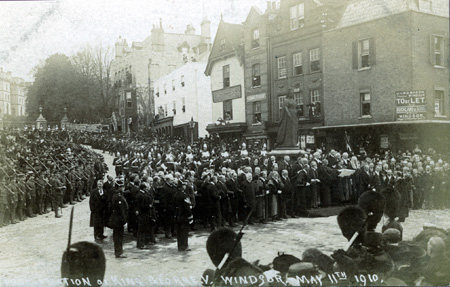
The Mayor Alderman
C F Dyson and Corporation of Windsor in front of the Queen Victoria
Statue at the foot of Castle Hill as the Proclamation is read
of the death of Edward VII and the Accession of King George V.
The photo above
was taken by T E Cochrane of Queens Road, Windsor. A number
of his photographs and postcards of Windsor are included on this site.
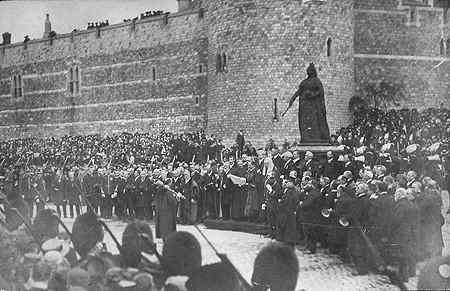
A similar view
of The Proclamation. Note the spectators above the castle walls.
King George
V's State Entry into Windsor
1st July 1911
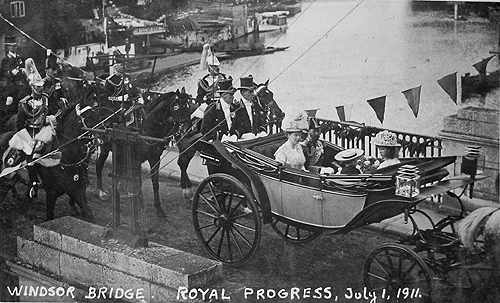
Following the coronation of King George
V on 22nd June 1911, nine days later the King and Queen, Mary
of Teck, processed from Slough through Eton and onto to Windsor
(the Royal Progress) in an open landau. With them were Princess
Mary, aged 14, looking towards the camera, and Prince George,
aged 9. Here they are halted on Windsor Bridge on their way from
from Eton. On the bridge they were addressed by Lord Desborough
on behalf of the Conservators of the River Thames before making
their state entry to Windsor where the Royal Party was greeted
by Mayor Frederick Dyson, the Town Clerk, Aldermen and Burgesses
of the borough, alongside other dignitaries, by Queen Victoria's
Statue.
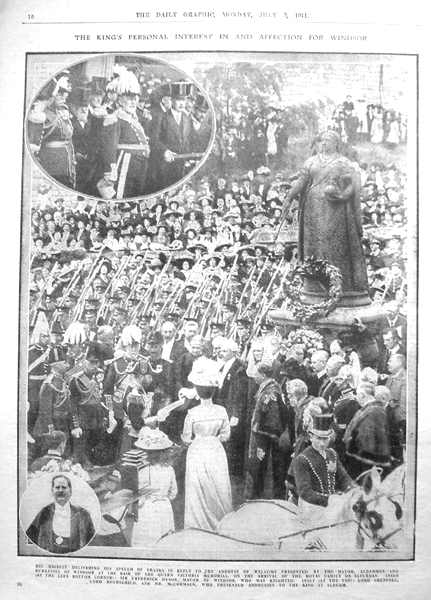
The Daily Graphic of Monday July 11th 1911
published a full report of the event, together with the full
page picture above. Here George V is delivering his Speech of
Thanks in reply to the Address of Welcome presented by the Mayor.
Inset top left: Lord Grenfell, Lord Rothschild
and Mr McCormack who presented addresses to the King on his arrival
at Slough.
Inset bottom left: Sir Frederick Dyson,
Mayor of Windsor, who was knighted at the foot of the Queen Victoria
Statue.
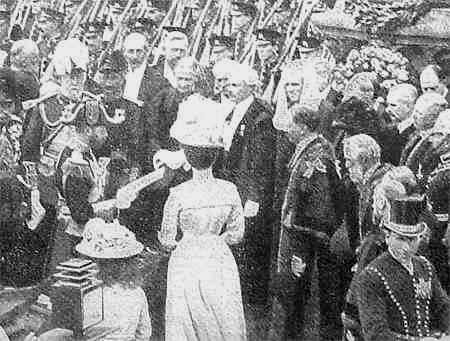 An enlarged view of George V from
the above full page photograph.
An enlarged view of George V from
the above full page photograph.
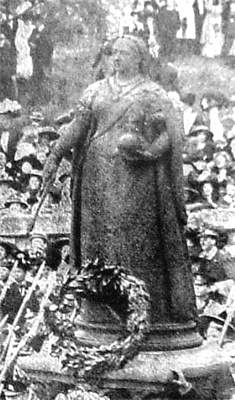
An extract from the Daily Graphic
full page photo showing a wreath at the foot of the Queen Victoria
Statue
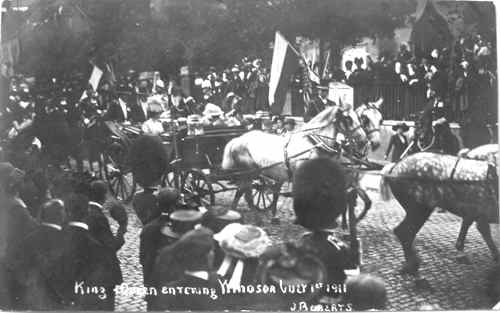
Although this picture is
a little indistinct, the royal party are now passing the Parish
Church in the High Street, Windsor on their way to Park Street
and the Long Walk to enter the castle by the George IV gateway
and into the Upper Ward (Engine Court). The postcard (photographed
by J Roberts) was posted by a member of the public who, according
to the message on the reverse of the card, is to be seen in the
church yard. The card was sent to a Miss Curran in Sussex on
July 11th. Apparently the sender was hoping to get a letter from
her! The postcard had been produced in just 10 days following
the State Entry.
The day's events were reported
by The Daily Graphic in their issue dated Monday July 3rd 1911.
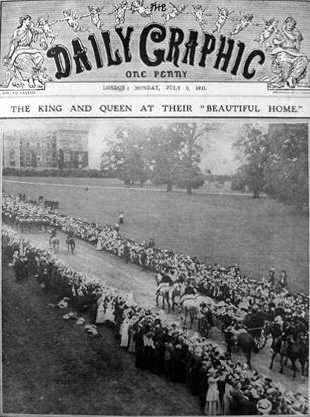
The Daily Graphic front
page showing the royal procession proceeding up the Long Walk
towards the George IV Gateway. These days this part of the Long
Walk is closed off to the public but in 1911, for this occasion
at least, the avenue was open to all.
The Daily Graphic caption reads 'Their Majesties joyously received at Windsor during
their drive through the private grounds to the castle - referred
to by the King as "Our Beautiful home" - where they
enjoyed a much-needed rest after the fatigue of the Coronation
festivities.'
The article below has been
scanned from The Daily Graphic, Monday July 3rd 1911, page 9.
Although we have taken care to read and correct it, if a mistake
is spotted, do please let us know!! To contact us, please email
Thamesweb.
Welcomed Home
To Windsor
Their Majesties'
Progress From Slough
Coronation Robes
Public Inspection at The Imperial Institute
Though the Coronation festivities
are over, the King and Queen are being kept busy in the country.
On Saturday they drove from Slough to Windsor, and received on
the way nine addresses, to which Royal replies were made.
To-day the King reviews the Officers' Training Corps
at Windsor, and tomorrow some 30,000 Boy Scouts.
On Wednesday the Court returns to London.
The King and Queen have most graciously arranged
that their Majesties' Coronation robes shall be on view at the
Imperial Institute for the week beginning on Monday, July 10th,
in order that the many visitors from the different parts of the
Empire and others now in London may have an opportunity of seeing
them. Further particulars will be announced shortly,
__________
A Day of Addresses
The King's Happy
Replies To
Nine Deputations
The Royal Family left London
on Saturday afternoon for Windsor, where the Court will remain
until next Wednesday, Their Majesties took train at Paddington
at five minutes past four, and alighted at Slough, whence they
drove in semi-State to the Castle, receiving en route no fewer
than nine addresses of loyalty and welcome, to which the King
made replies.
From Buckingham Palace to the station the Royal party
also drove in semi-State open carriages, with outriders, and
throughout the drive their Majesties were received with great
enthusiasm. The King wore the uniform of admiral, and the Queen
a fawn cloak and white hat trimmed with pink feathers. The Prince
of Wales, Princess Mary and Prince George rode in the carriage
with the King and Queen.
On arrival at Paddington their Majesties were received
by Viscount Churchill, chairman of the Great Western Company,
Lord Barrymore; Mr. S. E. Palmer, deputy-chairman; Sir James
C. Inglis, general manager; Mr. Charles Aldington, superintendent
of the Line; and Mr. J. Dunster, superintendent of the London
Division. The Royal special left in charge of Viscount Churchill,
accompanied by other officials.
Slough was reached at 4.32, and the reception accorded
to the Royal party was of the most cordial nature. Their Majesties
were received by Lord Rothschild (chairman of the Reception Committee)
and Lady Rothschild, Mr. W. Baring du Pre, High Sheriff of Buckinghamshire,
and Mrs. du Pre. Miss Peggy Behrens, a grand-daughter of the
Lord Lieutenant, presented a bouquet to the Queen, and Master
Jack Behrens handed a basket of flowers to Princess Mary.
"Our Neighbours"
A number of presentations
were made to His Majesty, who also received addresses from the
Slough Urban District Council, the Buckinghamshire County Council,
and the Buckinghamshire Territorial Association. The addresses
were handed to His Majesty by Mr. W. J. McCormack, Mr. Daniel
Clarke (deputy-chairman of the county council), and Lord Dalmeny
(vice-chairman of the Territorial Association) respectively.
Replying to the address of the Slough Urban District Council,
His Majesty said: 'The strong impression which we have sustained
of the spontaneous loyalty shown us by the immense assemblies
during our progresses through the capital in no way diminishes
our pleasure in the personal good-will of our neighbours and
those who know us in our home at Windsor."
In the course of his reply to the Buckingham County
Council, His Majesty said: "We shall often, when at Windsor,
have occasion to visit your county, and we feel sure that the
loyalty and affection to which the earnestness of your welcome
bears witness to-day will never fail us."
The reply to the address of the Territorial Force
Association of Buckingham contained this sentence: "It is
my wish and intention to follow in the steps of my father, and
to strive, as he did, to promote the welfare of the Territorial
Forces."
The arrival at Windsor partook of the nature of
the triumphal entry. The roadways, stands, balconies, housetops,
and windows all were packed with sightseers. The streets there
lined by Guardsmen, Territorials, and firemen. When Eton College
was reached a real Eton cheer rent the air. The guard of honour
furnished by the Officers' Training Corps presented arms, and
the cavalcade came to a halt in front of the school yard, where
their Majesties were received by the Provost and Headmaster.
Miss Warren presented to the Queen a beautiful bouquet of carnations,
tied with a Royal Blue ribbon, and Miss Lyttelton offered a similar
token of loyalty to Princess Mary.
The Provost then handed an address to the King on
behalf of the governing body, and Mr. J. B. Haldane, captain
of the school, presented one from the boys, both of which the
King accepted and acknowledged, amid bursts of cheering. Replying
to the Governing Body, His Majesty said: " We count upon
you to serve us still further by fostering in those committed
to your care a standard of manliness, knowledge, courtesy and
public spirit, which will not be unworthy of the renown of Eton.
To the King's Scholars and Oppidans of Eton College
and School, His Majesty said: "The British Empire requires
at the present time hard services from all its sons. It requires
the hardest service from those to whom most has been given. You
will, I am sure, in the course of your lives, lose no opportunity
of rendering service to your country and to the nation. These
opportunities occur in times of peace as often as in times of
war."
"The Pride
Of Englishmen"
The procession then moved
off, but on Barnes Pool Bridge there was a further halt in order
that an address might be presented from the Urban District Council
on behalf of the town. On Windsor Bridge Lord Desborough presented
an address on behalf of the Conservators of the River Thames.
The Royal reply to the Eton Urban District Council
contained an assurance that the welfare of Eton would always
be the subject of His Majesty's earnest solicitude; and to the
Thames Conservancy His Majesty said: "The Thames is the
pride of every Englishman who has learnt its story or experienced
the fascination of its summer beauty. The upper reaches which
you control contribute to the health and enjoyment of our people
as its tidal waters serve in the development of their commerce
and industries."
No sooner had Windsor Bridge been crossed than the
Royal Standard was hoisted on the Keep of the Round Tower of
the Castle. Joy bells rang out from the distant towers and the
populace cheered again and again. At the foot of Castle Hill
the Royal carriage stopped beside a dais near Queen Victoria's
statue, where the Windsor Territorials formed a guard of honour.
The Mayoress presented to the Queen a bouquet of carnations tied
with Windsor colours, and the Recorder of the Borough read an
address from the inhabitants, which the Mayor presented to the
King.
Replying to this, the King said: "It is my
earnest wish to know and understand the legitimate interests
and feelings of all classes of my subjects at home and overseas.
The progress and prosperity of Windsor holds an intimate place
in our thoughts. It has given me pleasure to be able to set aside
for your use as a recreation ground a portion of the Royal park.
The cultivation of physical efficiency is of peculiar importance
in the present age of mental exertion, and I feel sure that the
youth of Windsor will take full advantage of the opportunities
which will thus be afforded them for healthful and manly recreation."
Mayor Of Windsor
Knighted
Following this came an
unexpected but much appreciated incident. The King called for
Sir Henry Legge's sword and knighted the Mayor of Windsor, amidst
the cheers of the people, with whom Sir Frederick Dyson is very
popular. A number of gentlemen were presented to His Majesty
by Prince Christian, in his capacity as High Steward of the Borough,
amongst them being the Lord-Lieutenant and High Sheriff of Berkshire,
the member for Windsor, the Recorder, and the Town Clerk.
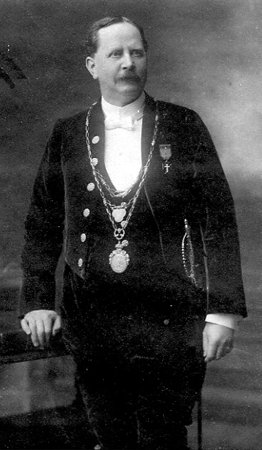 Sir Frederik Dyson
Sir Frederik Dyson
__________
TO-DAY'S REVIEW
The King, who is expected
to appear in field marshal's uniform, will ride on horseback
to-day from Windsor Castle to the parade ground in Windsor Great
Park where His Majesty is to review the Officers' Training Corps.
Queen Mary, the Prince of Wales and Princess Mary will drive
to the ground in an open carriage. The Duke of Connaught, Prince
Christian, and Prince Alexander of Teck will accompany the King,
and others in attendance will be Field Marshal Sir W. G. Nicholson
(Chief of the Imperial General Staff), Major-General J. S. Ewart
(Adjutant-General to the Forces), General Sir John French (Inspector-General
of the Forces), Field Marshal Lord Roberts, His Majesty's personal
aides-de-camp, and the officers of the Household.
__________
The King's Thanks
In a letter dated Friday
last from Buckingham Palace to the Dean of St. Paul's, Sir Arthur
Bigge says: "The King desires me to tell you how very much
pleased and impressed both this Majesty and the Queen were with
today's splendid and dignified service in St. Paul's Cathedral,
which their Majesties greatly appreciated and thought most happily
chosen. "The music was, as always, worthy of the Cathedral's
high reputation. His Majesty thanks you and all concerned, for
the very- efficient manner in which the arrangements were carried
out."
See also
The Royal Windsor Web Site will
report all events such as these and provide a permanent record
together with references to the background of such events wherever
possible.
Any information
or additional material about Windsor is always welcomed and acknowledged.
Copies of photographs or texts
can be emailed to the Editor,
The Royal Windsor Web Site

To contact us, email Thamesweb.
|

